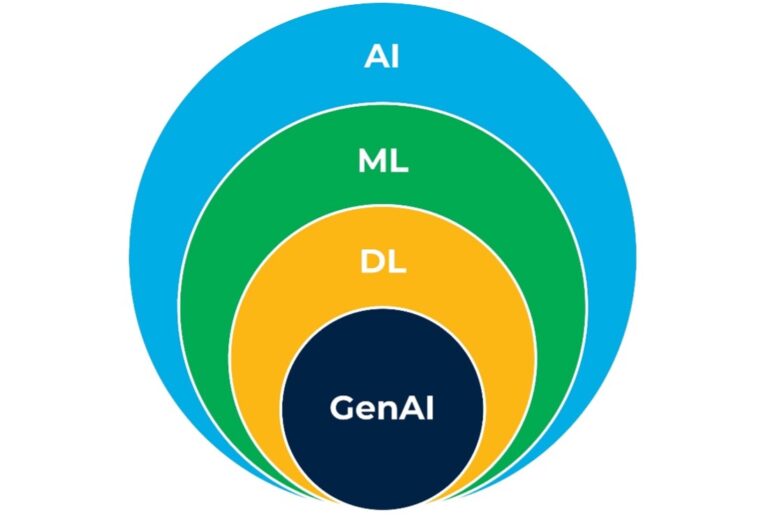For the laggards, there’s a growing sense of un-ease that they could be left behind. But either way, it’s clear AI is on the radar (or the actual agenda) of almost every CIO today, as there is a burgeoning sense of optimism that the hype has moved into reality.
With this, the vendor landscape is also ballooning fast with generative AI capabilities moving to the forefront, as players large and small are making concerted efforts to showcase their best use cases, product designs and potential benefits.
To help demystify AI, over this three-part series, we will attempt to ‘decode’ AI in a way that describes what it is and how a thoughtful enterprise data strategy is critical for AI success. Finally, we will share what’s next in this high-growth space, in particular, the financial services industry – so that you can gain a clear picture of the art of what’s possible for you and your organization. So, let’s dive in…
AI defined
Simply put, AI is the simulation of human intelligence processes by machines. It is the ability of a computer or robot to perform tasks commonly associated with intelligent beings, such as learning, reasoning, problem solving, and using language. In general, AI systems work by ingesting large amounts of labeled training data, analyzing the data for correlations and patterns, and using these patterns to make predictions about future states.
At its core, AI is primarily a probability engine, performing significant analysis and using mathematical/statistical methodologies to determine what the likelihood of observing a given output is, whether translating words, classifying documents or recognizing images. As AI right now is trained on existing or historical data, AI remains relatively unsophisticated when it comes to presuming or reasoning things that have never happened; However, with access to immense computation power, AI is capable of finding novel means of achieving a pre-defined objective by iterating through millions to billions of permutations of a task and evaluating the outcomes.
In a more accessible approach, AI currently is quite effective at leveraging off the shelf models to streamline convenience and making us more productive (e.g., Alexa, Siri), reducing errors and solving complex problems in a way humans cannot (e.g., processing copious amounts of data and identifying patterns).
One key misconception of AI is that it is synonymous with automation such as RPA (robotic process automation) or business logic-based algorithms. While automated systems must be manually configured to execute tasks, AI systems are independently adaptive once they have the data to process (e.g., learn as they go without constant intervention). Let’s keep this in mind as we explore some key types of AI.
Important types of AI technology
There are many fields of AI technology in existence today, each with its own capability to transform data in some way, shape or form. But, there is often confusion when discussing each of these areas and the benefit they have on our digital landscape.
- Artificial Intelligence (AI): As noted above, AI is broadly defined as the ability for machines to mimic human behavior to perceive, reason, and learn. The following three areas – Machine Learning, Deep Learning, and Generative AI – were born out of artificial intelligence. Common applications of AI include virtual assistants, natural language processing for text/sentiment analysis, and recommendation or search engines.
- Machine Learning (ML): The objective of ML is for machines to learn from data (data-driven learning) without the need for specific coding. These machines use algorithms to make decisions and detect patterns based on the historical data it is trained on. The lack of ML’s extensibility to be applied on unstructured data sets (i.e., voice recordings or video imaging) led to the emergence of Deep Learning (see below). Common applications of ML include credit scoring and fraud detection.
- Deep Learning (DL): Deep Learning utilizes neural networks to teach a machine to learn from the data to handle large, complex datasets and perform pattern recognition or generate predictions without explicit instruction. Common applications include autonomous vehicles and biometric authentication.
- Generative AI (GenAI): A subset of AI and Deep Learning, generative AI is a type of artificial intelligence technology that can produce various types of content, including text, imagery, audio and synthetic data. It takes raw data and “learns” to generate new statistically probable outputs when prompted. Common applications include Large Language Models (LLMs) such as ChatGPT and image generation.

A disruptive future is ahead
Simply put, the broader ecosystem of artificial intelligence is having a profound impact on businesses large and small – as well as for almost every type of consumer. Its potential to disrupt industries and the way companies operate is immense, and AI will continue to accelerate its development and permeation of the technology landscape around us.
It’s an exciting time to be a practitioner or technology chief – as the recent breakthroughs of the past year alone show that almost anything is possible with the right use cases. With this as a primer, our next article will dive deeper into the criticality of data as the foundation for enterprise AI success before we highlight real-world cases within the financial services industry to help further illustrate the use of this important technology for you and your organization.




